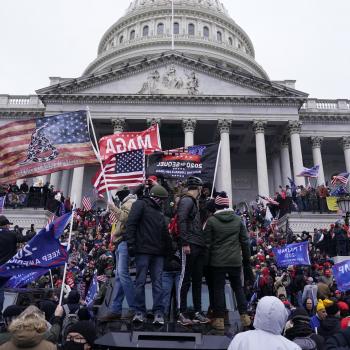On Sunday, Aug. 5, dozens of churches nationwide participated in a Hamilton Preach-In. Each participating preacher had a designated song from the show to highlight in their worship service. There will eventually be a link where you can go watch videos of all the different sermons (and some music). For now, here are my sermon notes on “Dear Theodosia.” Oh, and since we’ve got quite a few Ham-fans among the youth and children of our congregation, I hid a few lyrics from the show throughout the message. They had to listen and take notes, and I promised prizes to those who found them all. Now I have to come up with prizes …
I therefore, the prisoner in the Lord, beg you to lead a life worthy of the calling to which you have been called, with all humility and gentleness, with patience, bearing with one another in love, making every effort to maintain the unity of the Spirit in the bond of peace. There is one body and one Spirit, just as you were called to the one hope of your calling, one Lord, one faith, one baptism, one God and Father of all, who is above all and through all and in all. But each of us was given grace according to the measure of Christ’s gift. Therefore it is said, “When he ascended on high he made captivity itself a captive; he gave gifts to his people …” The gifts he gave were that some would be apostles, some prophets, some evangelists, some pastors and teachers, to equip the saints for the work of ministry, for building up the body of Christ, until all of us come to the unity of the faith and of the knowledge of the Son of God, to maturity, to the measure of the full stature of Christ. We must no longer be children, tossed to and fro and blown about by every wind of doctrine, by people’s trickery, by their craftiness in deceitful scheming. But speaking the truth in love, we must grow up in every way into him who is the head, into Christ, from whom the whole body, joined and knit together by every ligament with which it is equipped, as each part is working properly, promotes the body’s growth in building itself up in love.
—Ephesians 4:1-16
Fair warning: I can talk about Hamilton all day. That’s good news and bad news. Bad news if you’ve got lunch plans. Good news if you love Hamilton. And if you don’t already, hope to make you a believer.
For some context: After his home island in the Caribbean is ravaged by a hurricane, a young Alexander Hamilton crosses the ocean to get his education in the Colonies. He’s such a brilliant mind that the locals take up a collection to send him away to school. Early on (in the musical), he meets several new friends at a bar near campus. They are all just as young, scrappy and hungry as he is to make their mark, to be a part of something big. Something … Revolutionary, you might say. Among those friends—a man named Aaron Burr.
The show paints Hamilton and Burr as “frenemies” from the beginning. Both are very ambitious, and they have much in common. But they’re very different in how they achieve their goals. Burr doesn’t like to rock the boat. He is evasive, and always telling Hamilton to talk less and smile more. Hamilton, on the other hand, is all about rocking boats, starting fires and unsettling the status quo. So the two find themselves, from the outset, often at odds and in competition with each other.
There’s a scene towards the end of Act I that has both men, in separate places, singing to their newborn babies: Hamilton is singing to his son Phillip; while Aaron Burr sings to his daughter Theodosia. So named for her mother—who is someone else’s wife. They are singing their dreams of revolution, and of a new great nation, into these tiny people. Envisioning, in them, a future that they have glimpsed, and hope that they can bring about for their children. Like the broader themes of the show, this scene is about legacy—planting seeds in a garden you never get to see—and trusting the next generation to build what you started.
It’s not surprising that Hamilton: An American Musical has been such a runaway success. In this deeply divided time, it gives a snapshot of the original vision for our nation: not a place without boundaries, but with a different understanding of boundary and belonging. People from everywhere and nowhere coming to be part of this new dream. It was a place where even orphans and immigrants could leave their fingerprints; a reminder that you could come from a place of struggle and contribute to dream of belonging and prosperity
In that way, it was a vision much like that of the early church. As we’ve learned the past few weeks, the audience of the book of Ephesians was primarily Gentile; people who had long been outsiders but were now brought into a newly formed community. It didn’t matter where you came from or what you looked like—all were now made one in Christ.

Paul refers to himself as “a prisoner in the Lord” because he is literally writing this letter from prison. He writes like he’s running out of time—that’s where we got most of the Epistles!
I’d imagine that his place at this moment has him thinking a lot about boundaries. About walls and fences and what keeps people out—and what keeps them in. He’s probably got some new and profound perspective on what it really means to be bound; and how grace can free a person. So he’s writing to the church about life within the boundaries of that grace. That grace is abundant—and there is room within its defining lines for all. Jews and Gentiles, men and women, rich and poor … locals and immigrants alike. All things are brought into unity through love of Christ.
What is the fitting response to that life of abundant grace? He calls on them to broaden the boundaries of belonging. To understand those boundaries as not barriers, but as defining lines. Not walls, but something that shapes identity, gives meaning and purpose, and calls out the best gifts in everyone. This new covenant enables every member, no matter where they come from, to rise up, and build up the body in love.
But the Human fam, (then and now) seems bent on putting up more walls and boundaries. National boundaries, party lines, ideological camps, racial and economic barriers that literally separate rich neighborhoods from poor ones, and keep poor kids in different schools than rich kids. The Church today, like the church before us, is called to respond with grace. We are called to the work of expanding boundaries of belonging rather than drawing them more firmly, more tightly.
As Paul says “we are no longer children.” Maybe not. But in so many ways, we have still not grown up to be the people/the Church that God calls us to be. Here’s hoping our children do better. But what do we have to give them, so that they can?
I listened to a great episode of OnBeing, where the guest was author Luis Alberto Urrea. He talked about border walls as liminal spaces … Not necessarily two sides, but somehow transitional places … the beginning of something, or the place where two things meet and become one. All you have to do, he says, is go to the border where Mexican and American kids are playing volleyball across the wall.
He also notes that, on the Mexican side of our border wall, the whole thing is one big art gallery. Brightly colored graffiti, images of family and community and life. On the American side, it’s all steel and barbed wire, trucks and dogs, armed guards.
Who’s free? And who’s the prisoner?
Last week, a federal judge ordered that DACA be restored. But then another judge ruled to uphold the current policy. We are constantly fighting about who belongs here. Who got here “the right” way, who gets to stay, who deserves to walk on this soil and breathe this air. We even seem to be fighting over who gets to live. Friends of mine are in Arizona this week with a ministry called No Mas Muertes. They provide water in places of dangerous desert crossing. But they are also doing political work, to fight for the right to provide that water.
Did you know, in parts of Arizona, you can go to jail for assisting undocumented immigrants?
Walls within walls within walls.
We have still not grown up.
But it’s important to remember, in the life of the Church and our nation alike—this is not just a two-act play. This is a single chapter in a much longer, still-unfolding story. Take the long view, thinking not just about ourselves, but what we are building and leaving for our children. Looking at it from that angle, we might find that some of our self-imposed barriers are, in fact, keeping us bound more than keeping others out.
We’ll pass it on to you, says Aaron Burr … We’ll give the world to you, says Alexander Hamilton. I wonder if this is the world they meant us to have? I wonder if it’s the one we want to leave those who come after? Because it’s really us they were singing to, you know. Their children, and their children’s children’s children’s children. That would be us.
Hamilton captured the heart of the nation because it offers the best vision of who we are. Or who we like to think we are. Who our founding fathers meant us to be. They meant to build us a place, not without boundaries, but with reimagined ones … A place where even immigrants have a shot. A diverse culture, unified by a common dream.
Maybe the most captivating thing about Dear Theodosia is who’s singing it. Hamilton and Burr share these tight harmonies and this hypnotic melody; but—spoiler alert—you know how this is going to end, right?? Let’s just say … not well. But for just this moment, they aren’t adversaries. They are both just fathers, singing their future into being, loving these children into existence and putting their hope in a story that they want to see outlive them. Both have enormous egos that will ultimately be their downfall. But for this moment, it’s not about them. For the space of this song, they are able to see beyond the boundaries of self. And in that, they catch a glimpse of their part in a greater unfolding story.
Border walls might be liminal places. You know what else can be a liminal space? That crossing between sacred and secular; art and faith; pop culture and gospel. Isn’t that what we’re about, Church? On a good day? We give these things to our children—song and story, art and prayer; a place of belonging. Ultimately, a life within the boundaries of God’s grace, and the certainty of Christ’s love. That’s how we give them a shot at a better story. We give the world to them—not as it is, but as our faith can envision it—and they’ll blow us all away.












